 Jennifer Krasinski
Jennifer Krasinski
A stunning retrospective of over two hundred ceramic works, paintings, and textiles by the virtuoso artist.
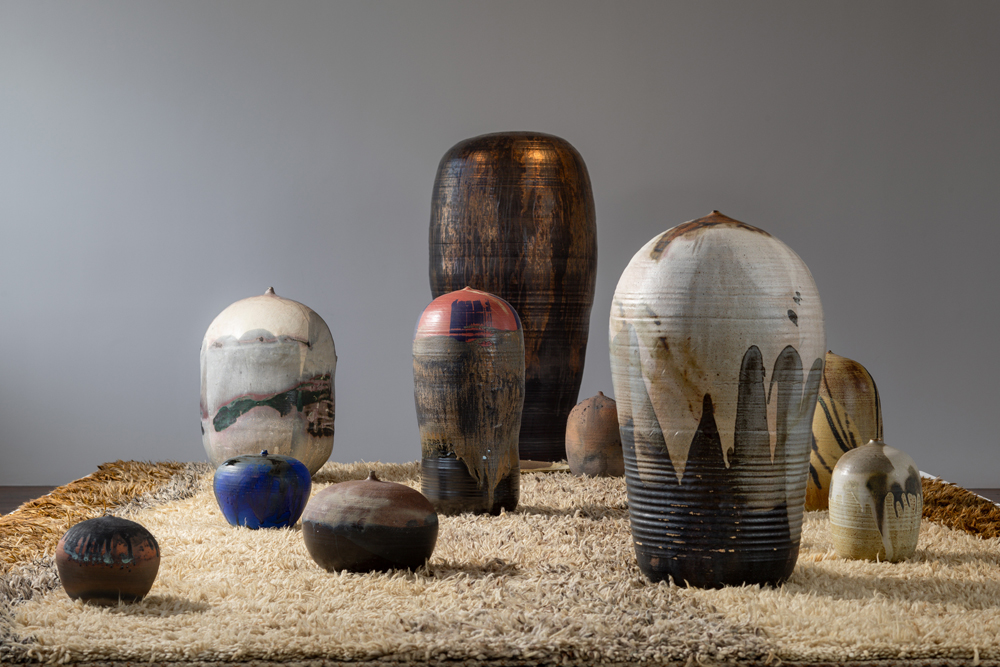
Toshiko Takaezu: Worlds Within, installation view. Courtesy the Noguchi Museum. Photo: Nicholas Knight.
Toshiko Takaezu: Worlds Within, curated by Glenn Adamson, Kate Wiener, and Leilehua Lanzilotti, Isamu Noguchi Foundation and Garden Museum, 9-01 Thirty-Third Road, Long Island City, New York,
through July 28, 2024
• • •
According to Toshiko Takaezu (1922–2011), good art isn’t necessarily the result of some material innovation or a scorching visual blaze (although, of course, these things matter). Rather, such work “contains a spirit and is alive,” possessed of an ineffable presence that cannot be gotten to merely by calculating the sum of its parts. Her appraisal isn’t as woo as it sounds. As a virtuoso ceramicist, her primary medium was clay, a material given forth by nature and therefore infused with something of its force. Instead of pursuing the “ideal form,” she took a cue from the Abstract Expressionists, allowing her hand to divine each object in the process of its making. Perfectionism was irrelevant. At the very least, she redefined perfect. Her vessels sometimes list a little to one side or are cracked, their glazes subtly bubbling, their surfaces decidedly unsmooth. As for their aura, one might wonder whether these things were excavated from the earth—or did they fall to it?
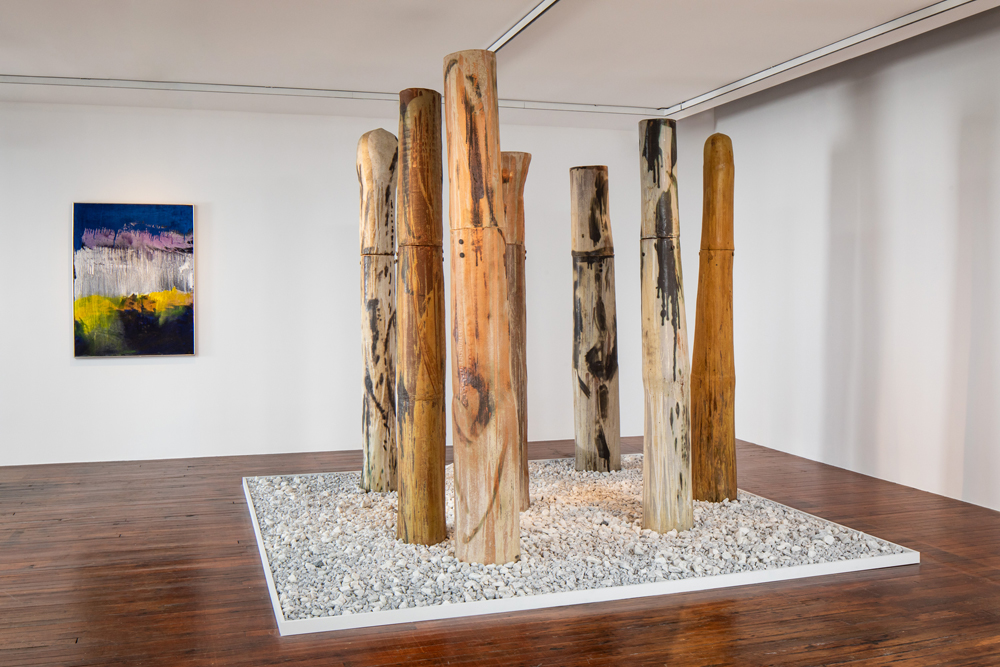
Toshiko Takaezu: Worlds Within, installation view. Courtesy the Noguchi Museum. Photo: Nicholas Knight. Pictured, far left, on wall: Tree Botan, 1973. Center right, foreground: Homage to Devastation Forest (Tree Man Forest), 1982–87.
Toshiko Takaezu: Worlds Within at the Noguchi Museum is a stunner, the first touring retrospective in over twenty years of this too-little-known artist, who also made paintings, sculptures, weavings, and even played with sound. Born in Hawai‘i in 1922 to Okinawan émigrés, Takaezu was the sixth of eleven children; she grew up on the Big Island, then later on Maui, where her parents took jobs on a relative’s watercress farm. She left high school in her sophomore year to help support her family, and in the early 1940s found employment, quite by happenstance, at the Hawaiian Potters’ Guild, the state’s first ceramic manufacturer. The Guild’s eighty-three-foot kiln mass-produced “gaudy” (the artist’s word) household goods like ashtrays and cookware, and although Takaezu hadn’t had any particular interest in working with clay before—a job was a job—it was, for her, love at first touch. She also proved to have a natural gift for it and an innate sense of clay’s expressive potential. “I knew there was something much more than making commercial things,” she later recalled.
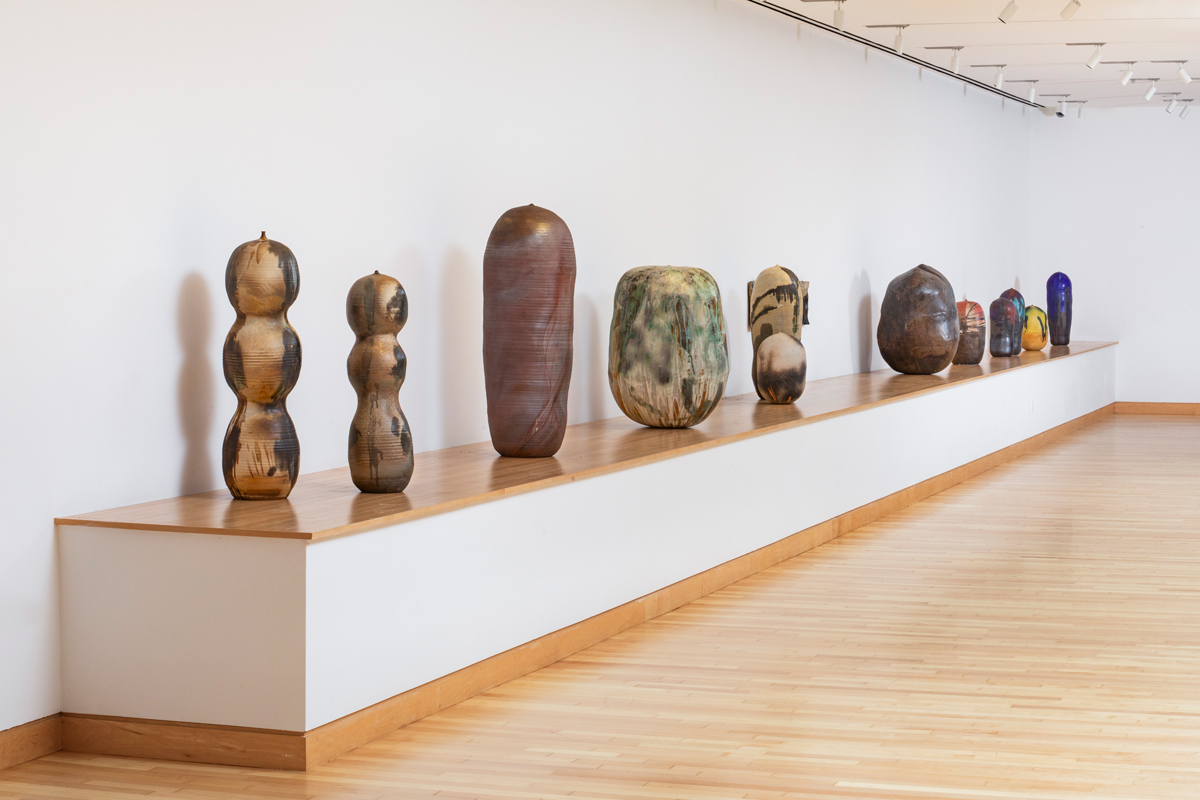
Toshiko Takaezu: Worlds Within, installation view. Courtesy the Noguchi Museum. Photo: Nicholas Knight.
In 1948, in her mid-twenties, she enrolled in the newly founded ceramics program at the University of Hawai‘i at Mānoa. Traditionally, the hands of ceramicists had been bound by matters of function—vessels such as vases and pitchers, as well as tableware and other domestic staples, were the classic forms—but these students were encouraged to embrace and explore nonfunctional possibilities, long considered an inarguable right by almost all other artists. In 1951, Takaezu was accepted at the Cranbrook Academy of Art in Bloomfield Hills, Michigan, which immersed her in a vastly different landscape, both natural and intellectual. Built on Modernist ideals, Cranbrook was home to some of the world’s most highly skilled and innovative artists, designers, and craftspeople, and for the three years Takaezu studied there, she threw herself into her practice, playing with new clay bodies and glazes and techniques, while also studying sculpture and weaving. Here she came into her freedom as an artist, learning that “everyone is unique and everyone should do his or her own work.”
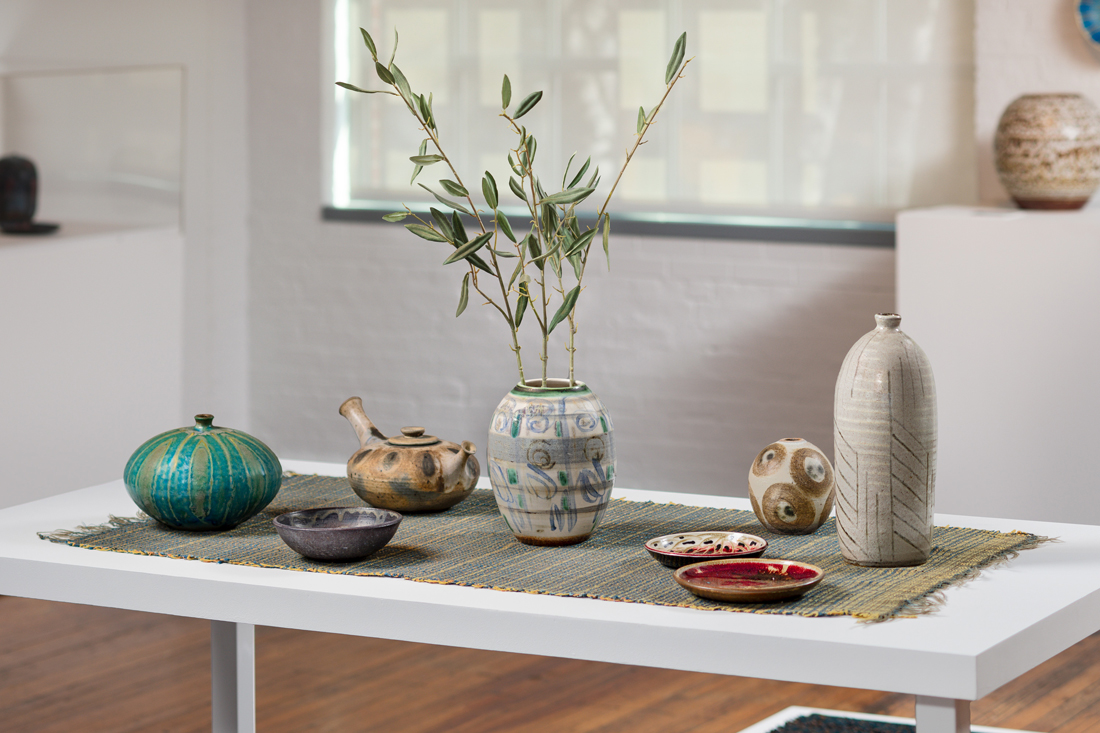
Toshiko Takaezu: Worlds Within, installation view. Courtesy the Noguchi Museum. Photo: Nicholas Knight. Pictured: stoneware plate, bowls, bottles, teapot, and vases from early to mid-1950s.
And so she did, as is made abundantly clear by the remarkable two hundred–some ceramics, textiles, paintings, and installations comprising Worlds Within. The earliest on view—see the plate, bowl, bottle, and teapot from the early to mid-1950s—capture her trying a variety of approaches to brushwork: from minimal, geometric lines, to loose licks of light color, to unbound patterns applied in thicker, more somber hues. (The curators have included select objects by the renowned Finnish ceramicist Maija Grotell and pieces Takaezu made in the studio of the astonishing Japanese potter Kaneshige Tōyō to clarify their great influence on the artist.) Around this time, she was having a lot of fun with teapots, too, making them with two, four, even six spouts, also connecting multiple vessels together to forge hybrid, near-beasty things—utterly useless for pouring, but expert at catching the eye.
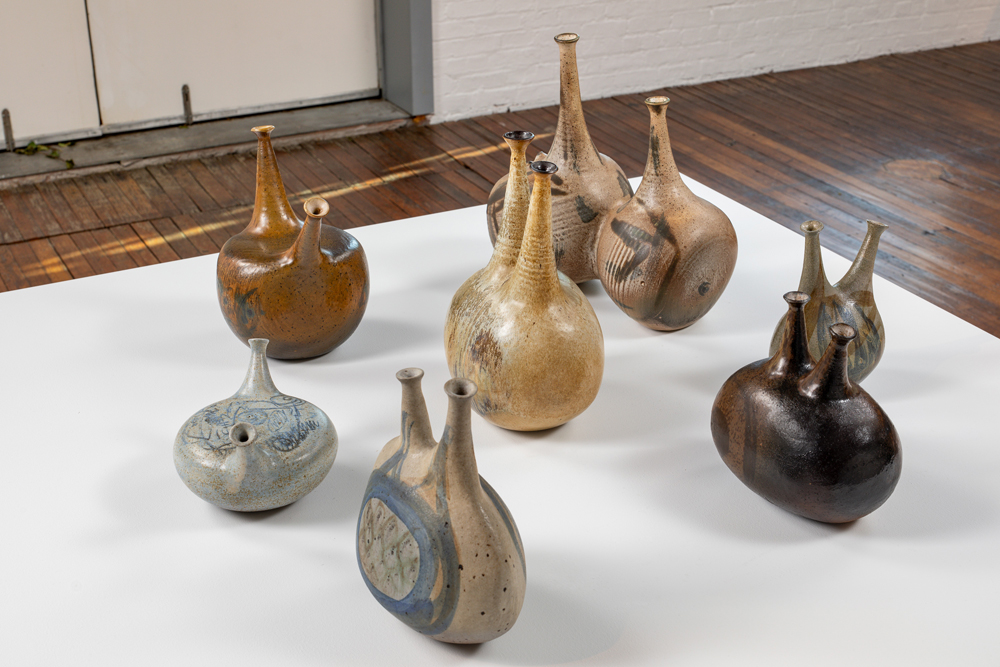
Toshiko Takaezu: Worlds Within, installation view. Courtesy the Noguchi Museum. Photo: Nicholas Knight.
Around 1958, after several years of experimenting in the studio, Takaezu developed what she called the “closed form,” which harnessed something of the undomesticated ethos of abstraction to synthesize object and painting into “one total and complete piece.” At the outset, her closed forms were vase-like, topped by the teensiest apertures, often no wider than the slenderest flower stem. The works became wider and rounder, then taller. Some took the shape of moons, others eggs, while still others she modeled after river stones and tamarind seedpods. All expanded the territory across which Takaezu’s brush grazed, glided, and bucked, at once creating and enhancing enigmatic, variegated topographies, no two alike.
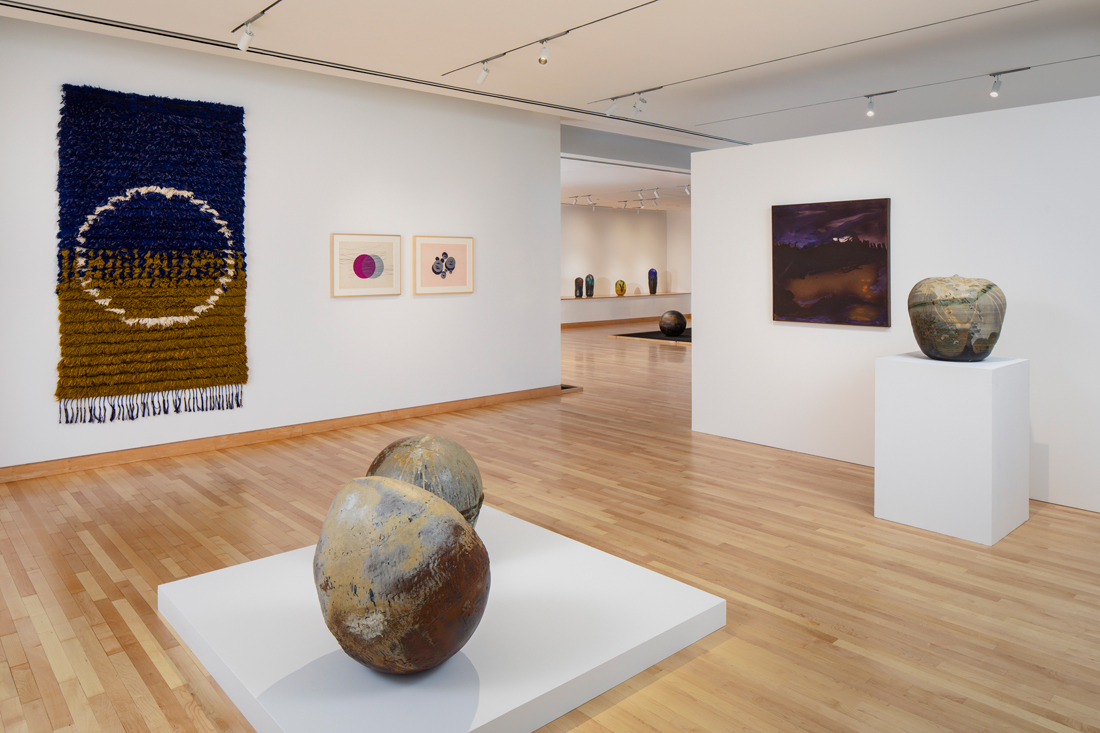
Toshiko Takaezu: Worlds Within, installation view. Courtesy the Noguchi Museum. Photo: Nicholas Knight. Pictured, far left on wall: Magic Circle, 1970. Right, on wall: Yu-Mé, 1972.
If there are any doubts that painting in three dimensions is a practice unto itself, Takaezu’s canvases, such as Yu-Mé (1972) and Tree Botan (1973), highlight how her colors and strokes become, well, flatter, more controlled, certainly when considered alongside the kiln’s unpredictable outcomes. The meticulous compositions of her lush woven works—see Magic Circle (1970) and Mutation (1970s)—mark the various speeds of her hand, as well. Perhaps what distinguishes Takaezu’s closed forms most is what cannot be seen: their interiors, and by extension their sense of interiority, call to mind those spaces that must be inferred, imagined, or apprehended in other ways. This isn’t mere projection: the artist secreted small bits of clay inside many of her vessels, so when the pieces are moved, they make variously pitched sounds. A video by composer (and cocurator) Leilehua Lanzilotti, closed form etudes (2023), captures some of the works being used as percussive instruments, shaken to assorted rhythms, revealing their particular resonances.
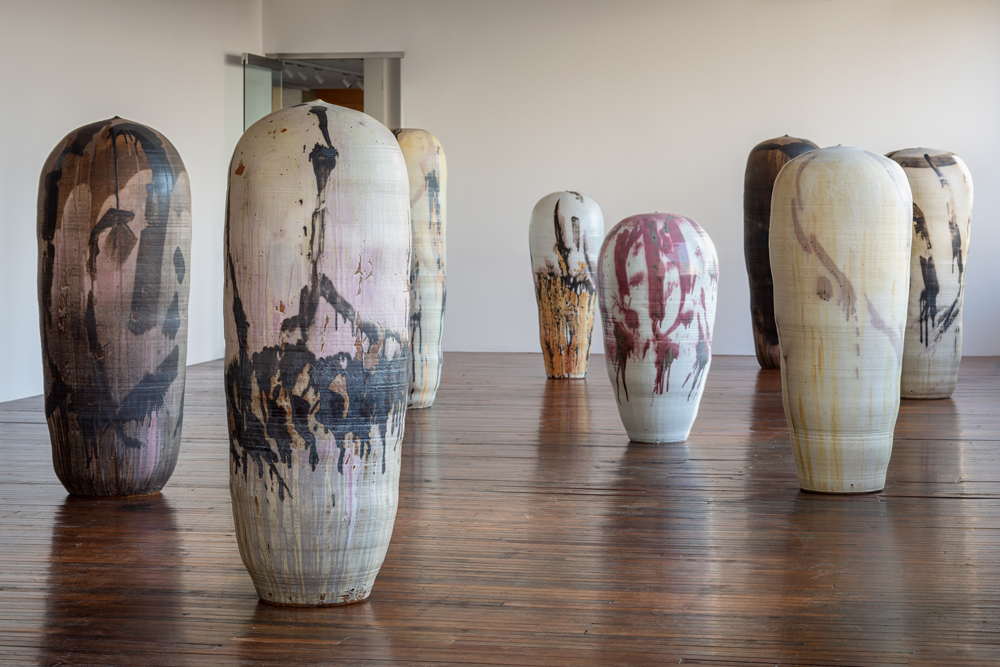
Toshiko Takaezu: Worlds Within, installation view. Courtesy the Noguchi Museum. Photo: Nicholas Knight. Pictured, foreground, left to right: Unas, Canopus, Nephthys, and Al Nitak (Great Pyramid), from the Star Series, ca. 1994–2001.
Scale matters in Takaezu’s work, shifting the intimacy of our encounters and repositioning our relation to her subjects. Her grand installation Homage to Devastation Forest (Tree Man Forest) (1982–87) memorializes those scorched when a volcano erupted in her home state. Tall, lean, and imposing, the ceramics feel cautionary, inviting awe rather than connection—“right sizing” us humans within the natural world and beyond. The artist considered the fourteen works comprising Star Series (1994–2001)—five of which are on view—to be some of her strongest. Visitors walk among them, circle them, take in the whole of them, freely. With names like Canopus, Draconis, and Nephthys, they are cosmically wondrous, even though their stature—reminiscent of urns, of sarcophagi—unsettles the spirit, too. Like form and color, life and death aren’t easily parsed, but Takaezu finds greatness by finely, beautifully, balancing and containing both at once.
Jennifer Krasinski is a writer, critic, and editor. She was a pinch-hitter critic and then an art columnist for the Village Voice between 2014 and 2018.